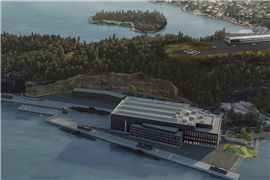Fleet financing
22 April 2008
Of these services, which can include service and maintenance plans, asset tracking and the like, it is finance that is becoming a particularly powerful sales tool. All the more so if you have a credit crunch which makes finance more difficult to find.
It is the biggest manufacturers who can engineer the best financial solutions. They can negotiate with the major banks and financial institutions, and because of their size and sales volumes can get favourable interest rates, particularly if you are a big customer.
“If it’s a major company, and if we want to be in business for the long term, they we may decide to do it [offer favourable interest rates]”, says Jacques Alpaerts, European head of Doosan Infracore Financial Solutions (DIFS), which is responsible for financing Bobcat products among other Doosan equipment.
This is one of the benefits of using a manufacturer’s ‘captive’ finance that is cited by Mr Alpaerts; “First of all, the fact of us doing what we are doing, and the weight of Doosan, means that funding will be more competitive. We go to our banks, ands they will know what we have done over the years.”
A spokesman for CNH Capital Europe, which finances Case and New Holland products, agrees; “One big benefit is our workforce. All of our salespeople are experienced in construction equipment and financial services. They talk to rental companies in the same language – the lifecycle, the models, the context. We talk to Case and New Holland people on a daily basis. We know the strategy and we can react immediately… we see where equipment is being used, its seasonality, and other special needs. We are in a better shape to sell the right financial product.”
This insider knowledge can be particularly important in new and developing rental markets where rental companies are starting from scratch without much of a credit history. French aerial platform manufacturer Haulotte Group, for example, has operated a finance division for around six years, and chief operating officer Alexandre Saubot says it has been particularly useful in these developing markets; “With companies from emerging nations, the leasing agreements can be complex. The assets are not always in place, but Haulotte can usually find a solution. We are getting very positive results for companies in Eastern Europe and Russia. Every case must be treated individually.”
Mr Alpaerts says the combination of volume of business, plus the manufacturers expertise in being able to re-market used machines, removes some of the risk for the banks, and makes it easier to obtain finance.
In Doosan’s case, the proportion of sales financed through DIFS is greater than 45%, which is considered to be a high level in today’s market. “I think it has had an impact on sales”, says Mr Alpaerts, “We think the incremental impact has been considerable.”
Rental companies are among its customers, and Mr Alpaerts says it is difficult to generalize about what these companies want; “We do quite a lot of business with rental companies, and each and every request is specific.” DIFS will offer operating leases – particularly popular in northern Europe – grace periods where no payments are required, or even seasonal payments for particular types of products. “We well offer seasonal payments even for small companies.”
All the major manufacturers have their own captive finance programmes, including Zaxis Finance (for Hitachi), CNH Capital, JCB Finance (formerly JCB Credit). Not all are happy to talk about their strategies in targeting rental companies, but it is clear that rental, with its growing importance on the market, is becoming a target area.
For example, Ewen Gilchrist, Komatsu’s rental business manager for Europe, tells IRN that it is in the process of developing dedicated packages for the rental sector, incorporating not just finance, but also maintenance, servicing, asset tracking and more.
He says all sizes of rental company use its finance arm, Komatsu Finance Europe, but thinks that the manufacturer-led programmes may benefit small and medium sized renters most of all, since many of the larger rental players have the financial strength and to arrange their own finance. Finance will, he says, becoming a key part of Komatsu’s sales armoury to the rental sector.
Of course, the credit crunch – and any consequent economic problems – could have a big impact on the level of sales of construction equipment. However, in terms of finance, a shortage of ready credit may well play into the hands of the ‘captive’ finance suppliers.
The spokesperson for CNH Capital, for instance, tells IRN that “there is an advantage for us in that we know the customers. In terms of risk taking, we are in better shape on what risks to take.”
That said, it does not appear that the credit crunch is having an enormous impact, yet. As Doosan’s Jacques Alpaerts remarks; “It hasn’t become easier [to raise finance], but I haven’t seen the effect of the credit crunch yet.”
Jeff Eisenberg, a financial consultant for rental companies who was heavily involved in financing Genie aerial platforms in Europe for several years, says the credit issue “is an opportunity for financiers to raise pricing a little. There will still be money around, it will just come a little slower and be a little more expensive.”
So should you take advantage of what the manufacturers are offering? “My advice”, says Jeff Eisenberg, “if you are a quickly growing rental company, then you will probably want to use both [manufacturers captive finance and other conventional finance sources.”
He agrees that the manufacturer programmes are more likely to understand the specific needs of rental companies, pointing out, for example, that many standard equipment leasing agreements in Europe require the financed asset to be stationary (and for the finance company to know exactly where it is). Something that is clearly a non-starter for rental companies.
By the same token, manufacturers are more likely to offer equipment at lower deposits – sometimes even no deposit – whereas banks will generally want more upfront as security.
It also pays to ask if the captive finance house is performing well. Mr Eisenberg says that a “successful captive finance organisation will be happy if it’s doing a third of total sales.” By that guide, Doosan is doing well: if you know that your captive supplier has a significantly lower level of business, then it would be a good idea to find out why (it could simply be that it’s interest rates are not competitive).
Mr Eisenberg also says that it is the manufacturers who may well be the best source of operating leases. Not every rental company likes operating leases, since the residual value of the machine at the end of the lease lies with the finance house or manufacturer, which removes a revenue earning opportunity for the renter. However, Mr Eisenberg points out that it is the manufacturer who, in theory, is well placed to understand the true value of the machine. This gives the manufacturer confidence and means that the rental company can benefit from competitive rates.
This confidence is likely to be further bolstered in the future by telematics solutions that can give owners and manufacturers rich data on the actual use of a machine over its working life. (Komatsu Utility said recently that experience from Japan with its Komtrax asset monitoring technology had led to significant increases in used equipment prices.)
It might also pay for a rental company to have a mix of operating leases and traditional hire purchase agreements, giving it some exposure to residual values, but not total exposure.
It seems that this varied approach to equipment financing is indeed what many rental companies opt for. Cramo’s chief financial officer, Martti Ala-Harkonen, tells IRN that it uses a mix of its own cash flow, syndicated loans, financial leasing and off-balance sheet leasing (operating leases).
The off-balance sheet financing represents a relatively small proportion of its purchasing – it had operating leases valued at €30 million at the end of last year, less than 10% of its fixed assets – and these are often through its vendors and for ‘big-ticket’ items where there is more risk attached. Mr Ala-Harkonen says the value of operating leases will increase a little this year, possibly up to €50 million.
One other concept that Cramo is looking at is rental share agreements, where the machine – often a large or niche product – is kept on the balance sheet of the manufacturer, with Cramo taking on the responsibility of renting it through its network. In such cases, the rental company and the manufacturer share in the proceeds of the rental.
“These arrangements are lucrative for certain types of equipment, typically heavy machines where utilisation may not be very high. It depends if the machine fits, or adds value to the service provider concept,” he says, “We don’t have many of these arrangements, but it is an interesting area to explore.”.
Cramo hasn’t yet relied heavily on vendor programmes, it may consider doing more. It was to host a vendor meeting, attended by over 100 of its equipment suppliers, in mid-February. As Mr Ala-Harkonen says; “It will be interesting to see what is on offer.”






